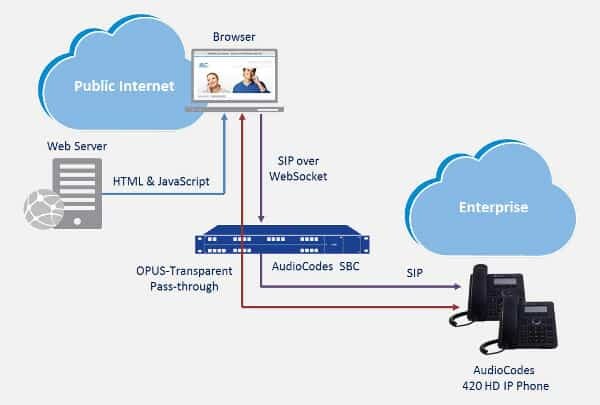WebRTC in the hands of a VoIP vendor.
Getting Israeli vendors to interview is a hard task. This time, I managed to get AudioCodes on an interview.
 For those who don’t know, AudioCodes is one of the companies that have been around since the dawn of VoIP. They have a good reputation and good products. I met Yossi Zadah, Director, Solution Marketing at AudioCodes on several occasions. I enjoyed all of these occasions and took the time to learn from them.
For those who don’t know, AudioCodes is one of the companies that have been around since the dawn of VoIP. They have a good reputation and good products. I met Yossi Zadah, Director, Solution Marketing at AudioCodes on several occasions. I enjoyed all of these occasions and took the time to learn from them.
I was happy to get Yossi to answer my WebRTC-related questions.
What is AudioCodes all about?
AudioCodes is a VoIP pioneer. Our products are sold worldwide to service providers and enterprises connecting between different VoIP networks and vendors. We have a rich product portfolio that includes Session Border Controllers (SBC), Multi-Service Business Routers, Media Gateways, Residential Gateways, IP Phones, Media Servers and Value Added Applications.
What excites you about working in WebRTC?
I am a little ambivalent towards WebRTC. On one hand, there is a huge hype and it seems that from a potential aspect, the sky is the limit. On the other hand, as you wrote after the Atlanta WebRTC convention last year, all the applications are Skype look-a-likes and until now, there haven’t been any killer apps.
I believe that in the short term, WebRTC will not replace all the current OTT IM/Social networking applications; my kids will continue using WhatsApp for instant messaging (IM) and Facebook to share posts. In the obvious applications such as contact centers and Unified Federation, the first phase WebRTC will be used partially for audio and file sharing; the video channel has various implications both technically and socially, and it will take time until this technology will be assimilated.
So where is the excitement? Small businesses… Those that don’t have a contact center today, where on the other side of the WebRTC client awaits a craftsman or any other service provider who would greatly benefit from video collaboration to help him/her build familiarity with potential customers. In addition, WebRTC can be relevant in all the applications where video and data sharing are necessary, such as eLearning, remote health consulting, etc.
You decided to add Opus to your IP phones first and only later take care of WebRTC in your SBC. Why is that?
Coders have been our bread and butter for the past twenty years, so naturally we have implemented Opus in our products, first in IP phones, and then in SBCs.
We assume that some use cases, for example, Contact Centers, WebRTC Web Socket, DTLS, and ICE, will be terminated by a WebRTC GW, but in order to maintain the Opus quality end to end and to reduce transcoding overhead, we added Opus to our IP phones.

How was your experience in getting Opus embedded into your proprietary hardware?
Opus transcoding is CPU intensive, much more than regular coder transcoding. Therefore, most of the implementation efforts were around optimization, first on our low cost IP Phone processors and then the SW transcoding on servers.
Any plans of doing things on the server side as well?
Of course, as a solution provider, we are implementing WebRTC GW in all forms:
- SIP/WS gateway – to terminate WebSocket from the WebRTC client and convert it to UDP/TCP/TLS to the SIP network
- Media – terminating DTLS/ICE/STUN/TURN, multiplexing, bundle and SRTP to RTP
- Web API for SIP gateway control – using REST API for GW configuration, management and status of the GW
- Transcoding – Opus to other codecs
- Transparent media pass-through – Terminating DTLS and passing voice and video transparently
- Enabling recording – Since all media is passing transparently through the GW, we enable media forking for recording purposes through SIPREC
What role do you foresee WebRTC playing inside enterprises with existing VoIP deployments?
I believe that in a few years, WebRTC will change the Unified Communication applications dramatically. Instead of thick UC clients requiring lengthy installation and constant maintenance, it will be replaced by a WebRTC-based client, which will be easily customized for each enterprise and seamlessly resolve remote user access, connectivity and security issues.
Moreover, AudioCodes will provide federations solutions to connect current UC systems that do not support WebRTC to WebRTC clients.
Where do you see WebRTC going in 2-5 years?
The big news about WebRTC will be in enabling VoIP in places where we don’t see it today, such as the Web domain. If WebRTC will not be over-standardized, adding it to a webpage will be like adding any other widget today. Someone else will take care of the service and connecting that webpage to legacy networks. This is also where we believe AudioCodes will play a significant role as we have the knowhow of how to bridge between the networks and vendors’ products.
If you had one piece of advice for those thinking of adopting WebRTC, what would it be?
Keep it simple. This relates firstly to the signaling layer on top of WebRTC. Think what you put there based on your application requirements. Sometimes it will be SIP but not always. Secondly, maximize the flow end-to-end and avoid server overload. Adding the codec and media encryption/decryption to the endpoints is one good example for this. AudioCodes acted in this direction with IP Phones as you wrote earlier on your blog.
Given the opportunity, what would you change in WebRTC?
The WebRTC arena gathers the Web geeks and the VoIP dinosaurs, and that’s an amazing clash such as between fire and water and one you can see in WebRTC conferences. The Web guys would like to start from scratch, NO SIP! NO SDP! And the VoIP dinosaurs keep asking if it’s working why change it? We in AudioCodes have these arguments internally on a daily basis…
What’s next for AudioCodes?
AudioCodes is a small company with very high targets. We bring 20 years of experience and expertise to the voice arena to provide end-to-end solutions; IP phones, mobile applications, MGW, SBC, router, MSBRs and more. In addition, we have tools and knowledge to provide Voice Network Readiness Assessment and further consultation for optimal voice enhancement. In all areas we have room to grow. As for WebRTC, as we speak we are rolling out our WebRTC demo kit that includes an SBC as a WebRTC GW, Opus IP phone and WebRTC web server. Customers interested in playing around with our demo are welcome to contact us.
